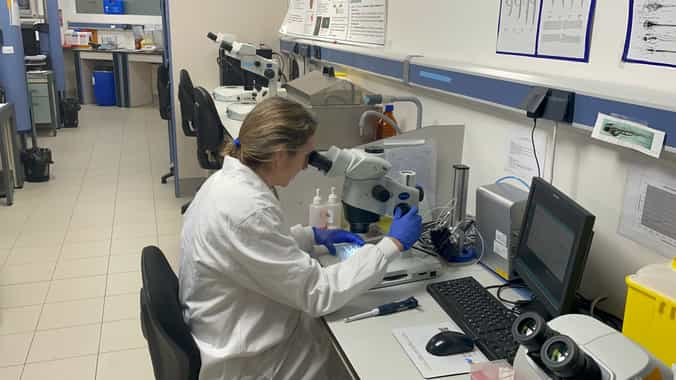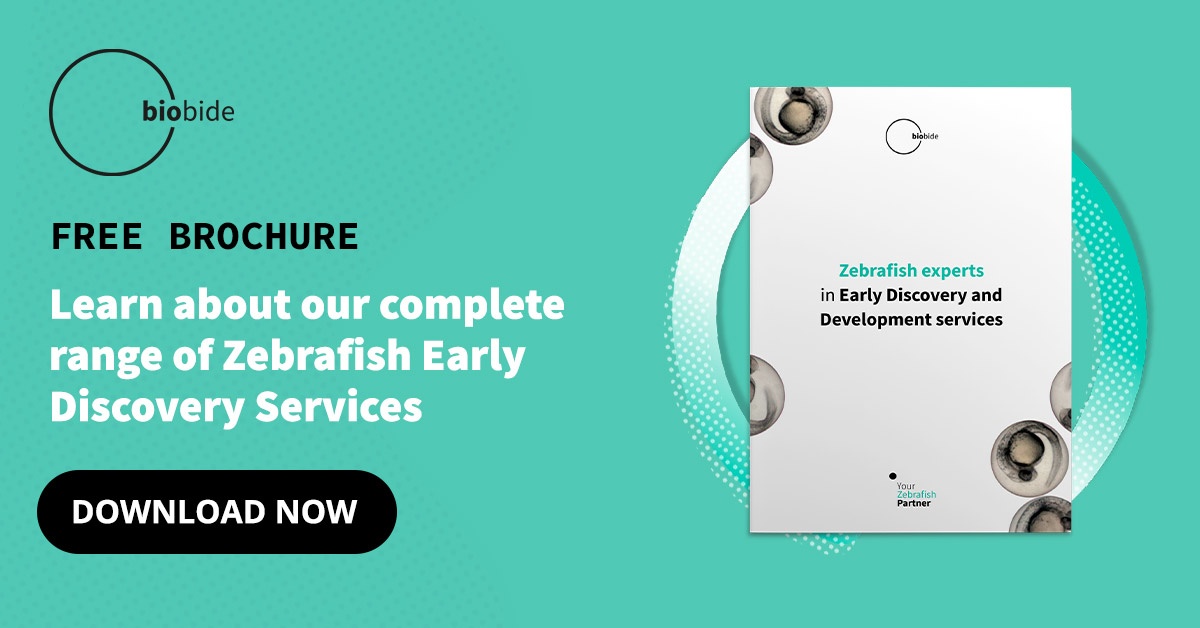Reproductive toxicology studies how drugs affect the reproductive system, including harmful side effects that can impact the parents (reproduction) or the offspring (development). Therefore, these substances affect the ability of an organism to reproduce.
There are many biological systems and sexual behaviors that can be affected, including the processes involved in the embryo, from conception, gamete production and viability, and even to the reduced fertility in offspring. In addition, substances that interfere with or affect the development or maturation of an organism, known as teratogens, as all of these aspects are related to developmental toxicity. Developmental toxicity can be a result of either the parent’s exposure to a substance before conception or the offspring’s exposure to a substance during gestation.
Conventional mammalian animal tests for assessing developmental and reproductive toxicity are laborious, costly, and time-consuming. Thus, there is a need for the development of alternative assays that offer cost-effectiveness, adequate throughput, straightforward assay conduct, reproducibility, and concordance with in vivo mammalian data.
The ICH S5 (R3) Giuideline on reproductive toxicology that implicates that all pharmaceutical products have to be tested in reproductive and/or developmental toxicity studies to demonstrate they do not affect those reproductive and development processes in humans, proposes the use of New Alternative Methodologies (NAM) as part of an integrated testing strategy to minimize the use of animals, according to 3Rs Principles (Reduction, Refinement and Replacement). In this sense, the use of zebrafish larvae is an attractive New Alternative Model (NAM) for the Drug Discovery and Development process, which is aligned with the animal testing reduction strategy. Thus, the zebrafish larvae model accounts for many benefits as they present a similar development process to mammals, and many of the molecular pathways present in humans are evolutionarily preserved, being a highly predictive model to analyze drug effects in humans. Also, is a cost-effective and easy-to-maintain model, and their external development makes it very feasible to treat and monitor the affections they present. Thousands of compounds are Drug candidates in preclinical phases during the Drug Discovery process. Many of these compounds are New Molecular Entities (NMEs), which are chemical compounds that present active modes of action that have not received the approval of a regulatory agency like the FDA and they may present unexpected toxicity. In this context, one of the many benefits that the zebrafish model offers precisely this, it allows us to test developmental and reproductive toxicity. in a fast High Content Screening (HCS) of Drug candidates for testing a large number of compounds.

Thus, zebrafish can be used as an alternative screening model for teratogenicity and reproductive toxicity, measuring the teratogenicity with the morphological alterations in the embryos and complemented with the Sperm Quality Analysis for the reprotoxicity evaluation. Even adding the endocrine disruption analysis (Endocrine Disruption Assay) to predict better some indirect teratogenic effects due to endocrine disruption in humans.
Teratogenicity
Renowned agencies including the Organization for Economic Co-operation and Development (OECD), the International Conference on Harmonization (specifically the ICH S5 R3), the United States Environmental Protection Agency (US EPA Health Effects), and the Council Regulation (EC), have in place prenatal developmental toxicity studies that provide general information concerning the effects of prenatal exposure on the gestational test animal and the developing offspring.
The teratogenic potential of compounds can be predicted quantitatively by ranking zebrafish embryos according to a scoring system of phenotypical changes, similar to the morphological assessments performed using the mammalian in vivo embryo-fetal development. Thus, the zebrafish model may support the screening model for teratogenicity as an alternative developmental toxicology model to predict effects in humans.
Biobide’s Teratotox Assay in zebrafish is an accurate tool to evaluate the teratogenic properties of potential drugs at an early preclinical phase in an HCS format and in a cost-effective manner.
To perform the Teratotox Assay, zebrafish embryos are placed in 24 well plates at 2-4 hpf (hours post-fertilization) and treated with the test compounds. The analysis is performed at 2 and 4-5 dpf (days post-fertilization) under the stereoscope and the minimum concentration at which lethality is induced is calculated.
Different organs and processes are analyzed under a dissecting stereoscope, including teratogenic and toxic endpoints including malformations, morphological defects, and the presence of edema or necrotic tissue among others. Several parameters such as EC50, LC50, Teratogenic Index (TI), and NOAEL values are calculated.
Further analysis like bioavailability can be performed by mass spectrometry to investigate the legitimate internal concentration of the test compounds and to extrapolate better to other models, but also to eliminate or to minimize false negative or false positive results. Complementary analysis such as histopathology or gene expression can also be performed.
Sperm Quality Assay
The Globally Harmonized System of Classification and Labelling of Chemicals (GHS) differentiates adverse effects on the reproductive capacity, from those adverse effects on the development of the offspring.
Exposures to environmental chemicals affecting androgenic activity during pregnancy are suspected to have a negative impact on male reproductive function. Male reproductive health is declining due to the increased incidence of testicular cancer, reduced semen quality, and other adverse syndromes. This is why regulating reproductive toxicity is of exceptional importance for the new active substances.
The zebrafish model can be very useful in determining sperm quality as an evaluation of reproductive toxicity.
At Biobide we have developed a Sperm Quality Assay that measures sperm quality after in vivo or in vitro exposure to xenobiotics to detect toxic effects on the process of reproduction. The analysis is performed using a computer-assisted sperm analysis with a negative-phase contrast objective, connected to a Computer-Assisted-Sperm-Analysis (CASA) system. The motility parameters analyzed include progressive motility, curvilinear velocity, and linearity. Reduced sperm motility is associated with compounds having a cytotoxic effect. More importantly, this specific assay can identify compounds that might generate a reduction in fertility after a long exposure by disrupting the overall process of spermatogenesis.
Endocrine Disruption Assay
Concerns about Thyroid Disrupting (TD) chemicals have increased because of the critical role that thyroid hormones play during development. Research on endocrine disruptors has demonstrated that they can play a significant role in human health problems as they can affect hormone pathways interfering with normal development, which can lead to irreversible health issues.
In particular, endocrine disruptors are known to influence fetal development causing premature birth and poor gestation. Infants born to mothers exposed to these disruptors can include low IQ in males, child behavior problems, and the appearance of diseases in later life. Fertility can also be affected, resulting in a reduction in sperm count.
To advance the study of endocrine disruptors, Biobide has developed a Thyroid Disruption Assay using zebrafish. This is an HCS assay based on the use of tg(tg:mcherry) transgenic embryos, which express red fluorescence in the thyroid gland under the thyroglobulin promoter, which is the main precursor of thyroid hormones. Increases in thyroglobulin levels will leads to an increase in fluorescence. The signal intensity is assessed in vivo to screen and characterizes potential TD, either directly or after metabolization by the zebrafish embryo. Additionally, gene expression analysis can be performed to obtain a more extensive characterization of the TD effect.
The assay has been validated with different reference compounds that are toxic and environmental pollutants targeting various Molecular Initiating Events (MIE) for disruption of the thyroid hormone axis. There are also specific substances like flame retardants or pesticides that may act as endocrine-disrupting chemicals.
Conclusion
The zebrafish model, using larvae in their embryonic stage, is a powerful NAM for Drug Discovery and Development, specifically, for teratogenicity and reproductive toxicology screenings, being especially useful in the early Drug Discovery phase where the toxicology profile of thousands of drugs must be tested in vast amount of candidates. In this sense, Biobide has developed a Teratotox Assay, Sperm Quality Assay, and Endocrine Disruption Assays using zebrafish larvae. These HCS screenings can highly predict the reproductive toxicology of hundreds of compounds in a fast and cost-effective manner being a reliable alternative to conventional mammalian animal tests.
Sources
- Teratogenicity Testing: Screening Drugs for Birth Defects (biobide.com)
- Zebrafish sperm quality assessment for reproductive toxicity (biobide.com)
- Testing Reproductive Toxicity in Early Drug Discovery (biobide.com)
- Developmental Toxicity: Testing Using Alternative Models (biobide.com)
- Reproductive Toxicology: Using Alternative Models for Testing (biobide.com)
- https://pubmed.ncbi.nlm.nih.gov/24503215/
- https://www.hindawi.com/journals/bmri/2013/726478/
- https://www.ncbi.nlm.nih.gov/pmc/articles/PMC3558154/
- https://www.jstage.jst.go.jp/article/jts/39/3/39_453/_article
- https://www.ncbi.nlm.nih.gov/pmc/articles/PMC7870776/
- https://pubmed.ncbi.nlm.nih.gov/34660207/
- https://onlinelibrary.wiley.com/doi/epdf/10.1002/bdrb.20223
- https://pubmed.ncbi.nlm.nih.gov/29896702/
- https://www.endocrine.org/journals/endocrine-reviews/endocrine-disrupting-chemicals-and-pregnancy
- https://academic.oup.com/edrv/article/42/3/295/6060059
- Endocrine Disruptors (nih.gov)
- Endocrine disruptors - ECHA (europa.eu)
- Guidance for the identification of endocrine disruptors in the context of Regulations (EU) No 528/2012 and (EC) No 1107/2009 - - 2018 - EFSA Journal - Wiley Online Library
- Endocrine Disruptors: Definition, Examples, and Role in Cancer (verywellhealth.com)
- AOPs Article on “An AOP-based alternative testing strategy to predict the impact of thyroid hormone disruption on swim bladder inflation in zebrafish”







